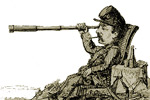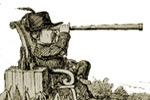
STOP #3
POWER'S HILL SIGNAL STATION |
This site was the location of Maj. Gen. Slocum's Right Wing headquarters and
was probably supported by Lieut. J. E. Holland who was temporarily attached to
the Twelfth Army Corps. This location was also an important artillery position
which was used effectively against Confederates on Culp's Hill.
The Power's Hill signal station played a part in Maj. Gen. Meade's decision
to move his headquarters to this location during the cannonade which preceded
Pickett's Charge. [Edwin B. Coddington, The Gettysburg CamDaign: A Study in
Command, Dayton Ohio, Morningside Bookshop, 1979, p- 496.] In an attempt to
notify Meade, news of Pickett's initial movement was signaled to this signal
station by Capt. David Castle who had remained at Meade's original
headquarters. The details of this event will be examined when you visit
Meade's headquarters at the Leister House.
When studying the various signal sites on this battlefield, it becomes
apparent that their selection was of the utmost importance. Col. Myer,
comments on the selection of signal stations:
A station should never be located in a camp, or among tents, or
where the white canvas of tents can form the background of signals viewed
from the other station ... Signal stations should always be chosen elevated
from the ground as much as is possible, when there is difficulty about
smoke, or haze, or dust. The undulation of the atmosphere, noticeable on a
hot summer's day, is always less at a distance from the earth's surface.
Thus it is sometimes practicable to read from a tree or a house-top when it
is almost impossible to so read from the ground. This undulation is less
also over spots well shaded than in the glare of the sun. This should be
borne in mind in all telescopic examinations. Permanent stations should
never be placed in hollows, or on low land, when high ground is attainable.
The greatest elevation should invariably be sought ... By careful selections
of high ground, stations can often be worked when signals on the lower
fields would be invisible. For these reasons, it is well to have, sometimes,
a station for night work on a house-top or in a tree, while during the day
the station is worked from the ground.
[Albert J. Myer, A Manual of Signals,
New York, D. Van Nostrand, 1866, pp.
246-247.]
Now return to your automobile and proceed to STOP 4.
Drive the short distance to BALTIMORE PIKE and turn left. Take the first
right at the park sign to SPANGLER'S SPRING and CULP'S HILL. Follow the signs
to the top of CULP'S HILL and park by the observation tower.
|




